A walk through the Albert Family Community Forest
By Claudia and Conrad
A few days ago, a friend suggested we go on a wonder wander in the Albert Family Community Forest of the Rensselaer Plateau Alliance in East Nassau, just a few minutes north of the Columbia County line. The trails took us through a variety of forest types, including some wonderful stands of Hemlock, and along a lovely tributary to the Kinderhook Creek. Here are some of the wonders along the way that drew our attention.

These drop-shaped icicles lined up along a reed suspended over the creek struck us as nature’s version of a perfect holiday decoration. Conditions have to be just right for these baubles to form—warm enough for there to be open water, cold enough for freezing on near-water structures.
A variation on the theme… can you imagine how these icicles got their flat bottoms?

… and another variation on icicles suspended over the water…
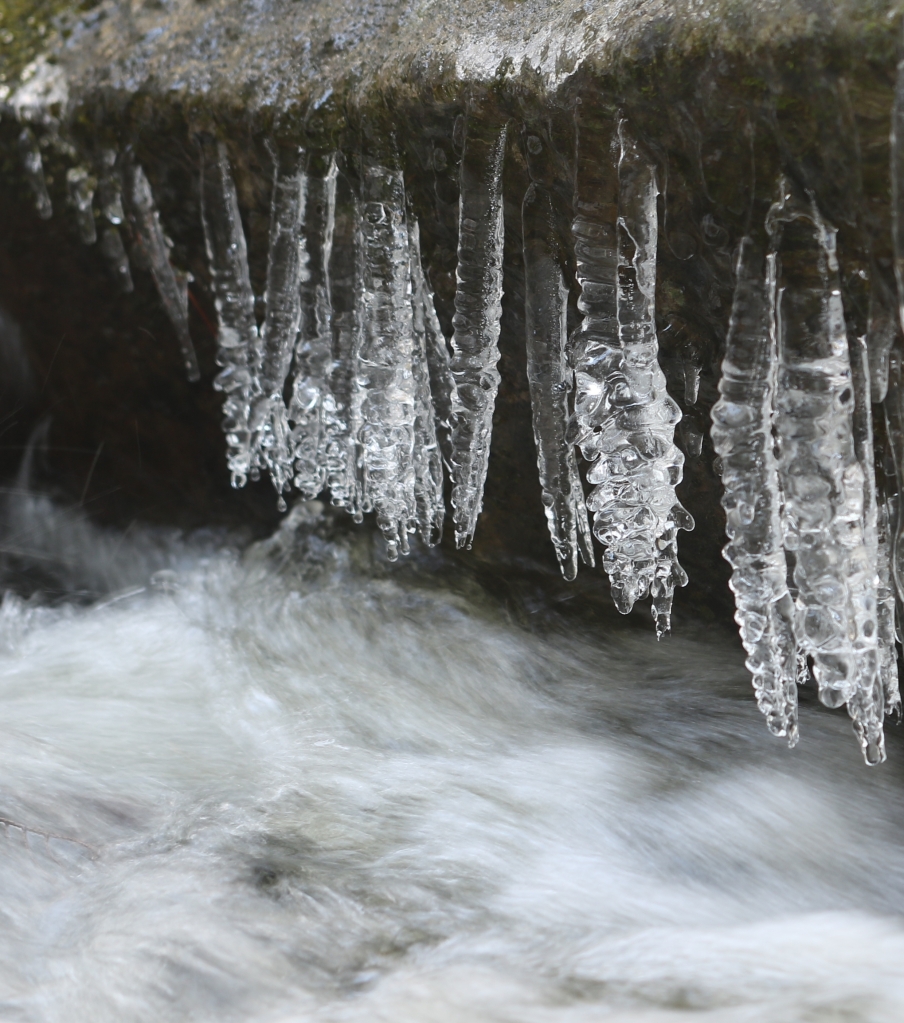
… ice on a moss-covered rock in the gushing stream…

… and finally, a celebration of water in its many forms!

Before returning back to the stream to illustrate its changing character along the trail, let’s see some of the tracks we found in the fresh snow and some of the signs of life we discovered on tree bark.
Do you have an idea, who made these tracks, which direction the animal was moving in, how fast it was going, and which print was made by which foot?
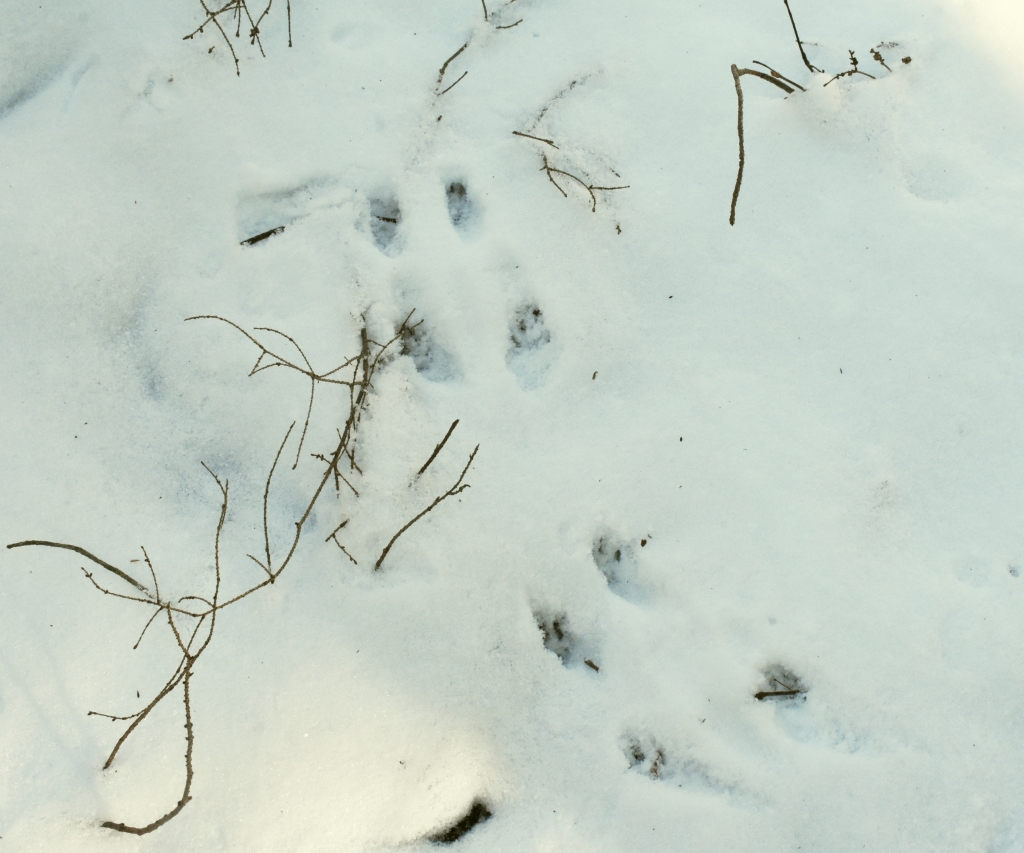
These kinds of tracks, with foot prints in “blocky” groups of four, often starting or ending at the base of a tree, were very common in the forest and were left by squirrels. Note that the toe imprints are pointing upwards in the image, so the squirrel was moving away from the camera. And I am pretty sure, it was not going very fast, because the distance between the two groups of four foot prints (the “stride”) is not much longer than the distance between the front and hind feet. My guess is that this squirrel was “hopping”, which means the pair of hind feet were placed behind the pair of front feet. If the squirrel had been “bounding”, it would have made longer jumps (the “stride” would have been longer), and the hind feet would have landed in front of the front feet. Unfortunately, this image does not allow to discern the number of toes (four in front feet, five in hind feet) to confirm my guess.
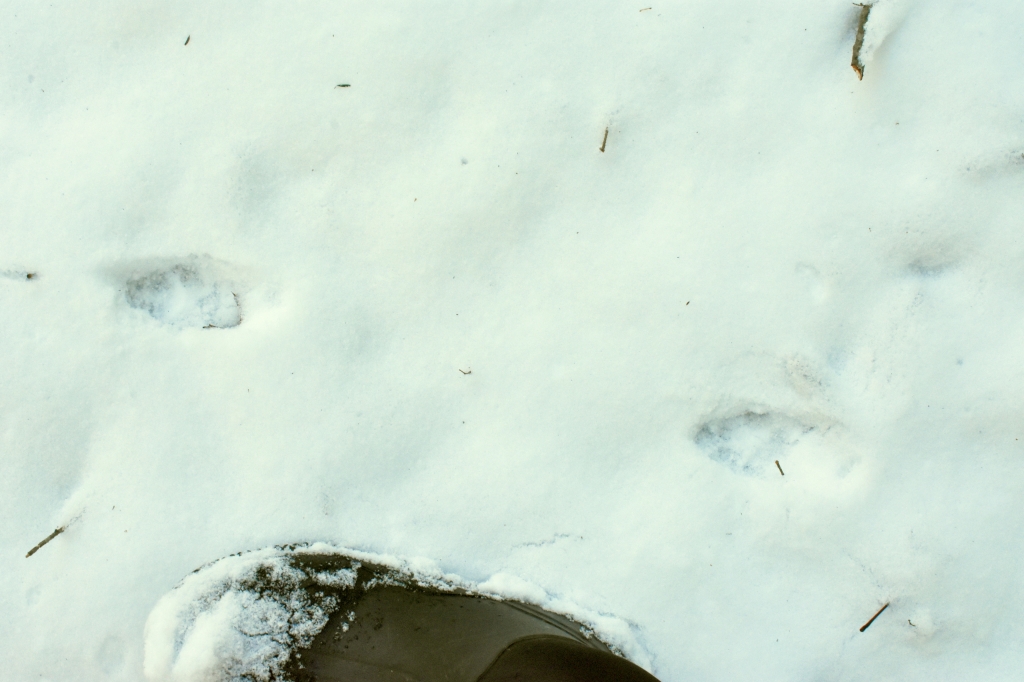
The above track is a typical canine (including dog, fox, coyote, or wolf) track moving to the left of the image in “direct register trot”. The evenly-spaced imprints are pretty much in a straight line and each imprint actually reflects two tracks on top of each other: the right (left) hind foot on top of right (left) front foot. The size of prints and their stride (relative to my boot) suggests that this is the track of a fox. Theoretically, it could be a smallish dog, but the track was not associated with human foot prints, did not parallel the hiking trail, and tracks were almost one in front of another (think pogo stick…).
Any guesses who might have been this little creature bounding through the snow, trailing a tail, and seeking cover under a small fallen log?
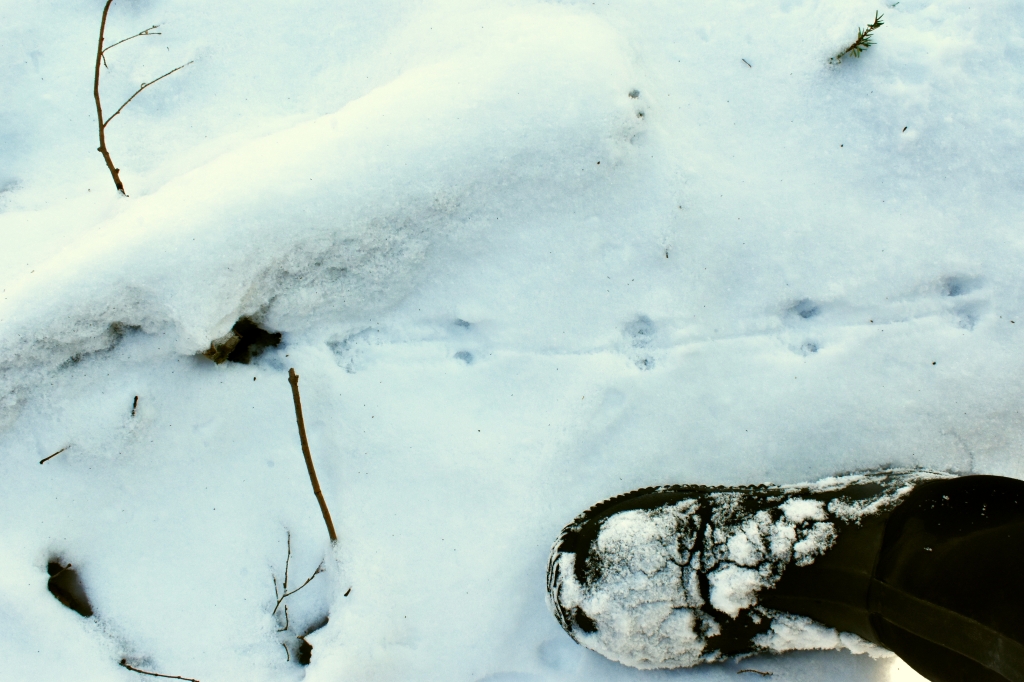
It was probably a mouse in the genus Peromyscus, that is, a Deer Mouse or a White-footed Mouse. They bound and have a long tail resulting in well-spaced “landing zones” connected only by the dragged tail.
Another track in the snow was very different. This evenly-spaced pattern of right (and left) front and back prints placed on top of each other in “direct register” was probably a Striped Skunk walking relatively slowly through the snow with the typical “skunk waddle”.

Although the tracks in the fresh snow were alluring, we also raised our gaze once in a while and were fascinated by tracks of a different kind. Any guess what might have happened in the image below?

We are looking at the bark of a White Birch, which has a green layer of algae that is partly removed along the grazing trails of one or several snail(s) or slug(s). In trying to figure out, what exactly we are seeing here, I came across an entire blog posting dedicated to the various interactions between snails, algae, and the bark of White Birch at https://www.toknowtheland.com/blog/snailtrailsonbirch. However, what interested me most, was the question whether one can actually determine from the grazing pattern, which way the snail/slug was moving. Can you guess?

A closer look at the grazing pattern reveals a sideways (in above and below image) back and forth motion of the head of the snail/slug as it was rasping the algae off the bark with its radula. You can imagine the radula as a tongue studded with sharp little teeth (similar to a cheese grater) which is moved out and into the mouth in a sort of licking motion. There are various videos on youtube to document this mode of eating. Supposedly, one can determine the direction of the snail’s/slug’s head by the forward- (in this image downward-) facing V-shaped patterns left by the radula with each “lick”, and which are lined up next to each other along the sideways movement of the head. So, if I understand this correctly, the snail/slug that left this trail was generally moving downward, while moving its head sideways and taking several (at the order of 10) bites or “licks” with its radula in each direction.

Many other trees did not just have the tracks of past activity on their bark, but were currently supporting other forms of life. How many different organisms can you spot on the bark in the image below? Do you have any guesses what life forms are represented?

We can discern at least four different life forms in this image (see them numbered in the photo below): (1) a layer of algae or crustose lichen; (2) a tuft moss (Ulota sp.); (3) a foliose lichen, the Orange-cored Shadow Lichen (Phaeophyscia rubropulcra); and (4) a liverwort (Frullania sp.). How many different forms of life can you find on the next tree bark you inspect? Are you seeing differences in the bark inhabitants of different tree species? Different tree sizes? In different habitats?

The following (and unfortunately not very good) image shows signs of past and future life of the same organism on a dead tree. Any idea what you are looking at?

Above my finger is the empty chrysalis of (probably a female) Gypsy Moth. The female Gypsy Moths are wingless and usually don’t move far from their place of metamorphosis. The flying males locate them by their pheromones, they mate, and shortly thereafter, the female lays her eggs in a pale orange-colored spongy mass. You can see the egg mass just to the right of the empty chrysalis. The little caterpillars will hatch next spring and—if there are lots of them—can defoliate entire trees, before they pupate and the cycle begins new. We have been seeing a lot of Gypsy Moths this year (see Conrad’s post from July 25, 2020 and are finding a lot of egg masses now—so we might have an “outbreak” of Gypsy Moth caterpillars next season… As Conrad mentioned in his post, when the density of Gypsy Moths reaches a certain point, a viral disease usually knocks them back, again.
Another sign of life (and probably impending death) we discovered on the bark of an American Beech.

While we have been aware of the Beech Bark Disease and know to recognize an infected tree by its uncharacteristically bumpy bark, we had never before observed this stage of the disease: thumb print-sized slight indentations in the bark, with an orange-brown margin and another circle of the same color inside.

Some digging around on the internet revealed, that this pattern is caused by the fruiting bodies (perithecia) of a fungus, Neonectrina faginata, which infects the bark of beech trees in the places where it had previously been pierced by a scale insect, Cryptococcus fagisuga. These two introduced organisms (which are occasionally joined by similar native species) act together to cause the symptoms of the devastating Beech Bark Disease, which is currently killing many of the larger beech trees in our forests.
Where the large beech trees suffer from Beech Bark Disease, small beech seedlings and root shoots are often quite common. The image below captures a young beech (left) accompanied by the dried stalks of Beechdrops (Epifagus virginiana; right) a native parasitic plant that taps into the shallow roots of beech for nutrients. Beechdrops are often found in the vicinity of beech trees (and never far from them!) and are not considered a danger to healthy trees.
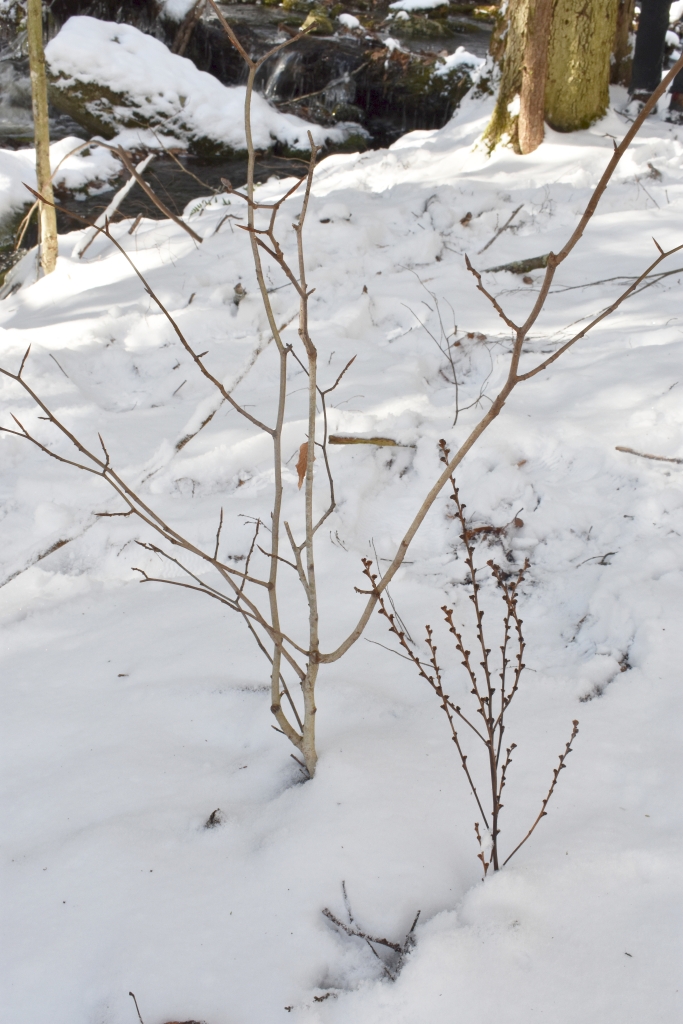
Now, for the rest of this post, let us return to the little stream and follow its various incarnations along the “Homestead Trail” and the “Cascades Trail”. The Homestead Trail meets the stream for the first time on a lively, rocky stretch, where we found many amazing ice formations.

Further along, the trail skirts a marsh where the same little stream calmly glides through the wetland vegetation.

Near the parking area, it emerges from a forested stretch into another small marsh.

After flowing under the road, it enters a brief stretch of relatively level terrain, where it is bordered by narrow bands of floodplain forest. (We are now following the stream on the Cascades Trail).

Soon, the banks become steeper, again.

And down it tumbles through another rocky stretch, surrounded by Hemlock Forest…
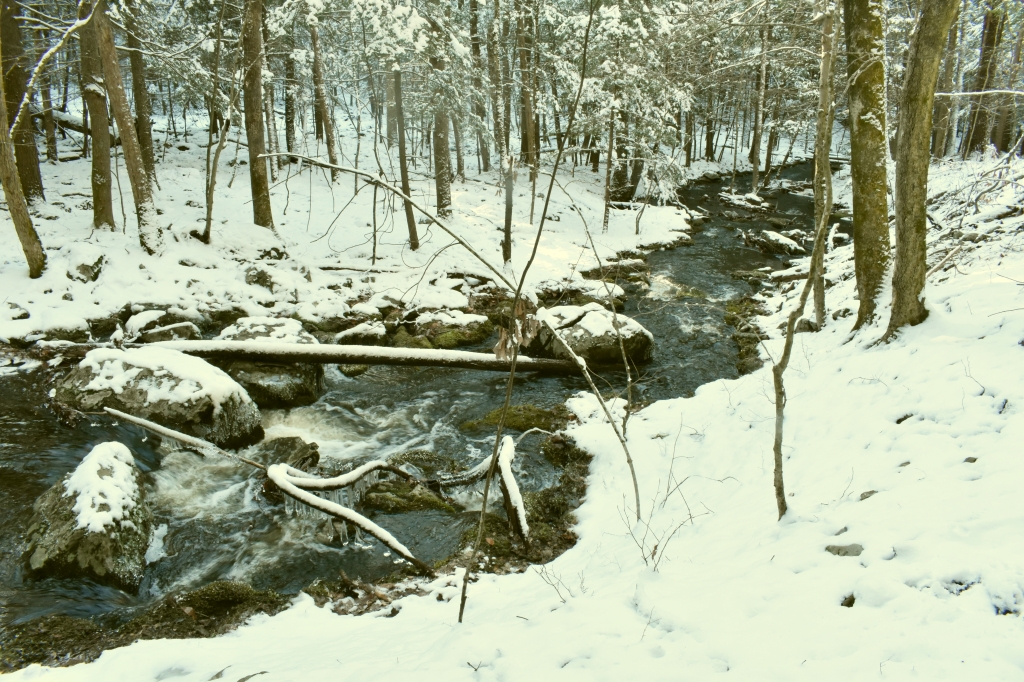
… to emerge into another open wetland, where it loses itself in the marshy vegetation, before gathering itself once more for the final push to join the Kinderhook Creek.

And here ends today’s Wonder Wander. Our heartfelt “Thank You” to the generous donors who are supporting these Wonder Wander posts and all of our other free offerings, such as the self-guided Wonder Wander Walks at different Columbia County Land Conservancy (CLC) areas and the self-guided Winter Botany Course at Crellin Park in Chatham. If you wish to join our circle of supporters, you can donate online or send a check to the Hawthorne Valley Farmscape Ecology Program, 1075 Harlemville Road, Ghent NY 12075.
The entire team of the Hawthorne Valley Farmscape Ecology Program wishes you a Happy New Year! May it bring you many memorable encounters with the natural world!


absolutely stunning- beautiful photos and wonderful information thanks from the heart for your work, knowledge and sharing with others
all the best for this coming year
pat thomas duluth, mn
On Wed, Dec 30, 2020 at 9:21 AM Progress of the Seasons Journal wrote:
> hvfarmscape posted: ” A walk through the Albert Family Community Forest By > Claudia and Conrad A few days ago, a friend suggested we go on a wonder > wander in the Albert Family Community Forest of the Rensselaer Plateau > Alliance in East Nassau, just a few minutes north of” >
LikeLike
The slug trails and rasp marks were amazing – I will have to keep an eye out for their beautiful ‘art’!
LikeLike